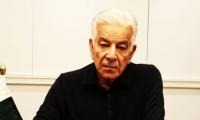ISLAMABAD: Pakistan is likely to witness the lowest growth of 2.8 percent in South Asia in the current fiscal year of 2019/20 as the government implements a program of macroeconomic and structural reform to stabilise the economy, Asian Development Bank (ADB) said on Wednesday.
“Given the need for the authorities to address sizable fiscal and external imbalances, the economy is expected to slow further, with GDP growth projected at 2.8 percent in FY2020,” Manila-based lender said in its Asian Development Outlook Update 2019.
“Fiscal adjustments are expected to suppress domestic demand, and demand contraction will keep growth in manufacturing subdued. However, agriculture is expected to recover from weather-induced contraction this year, with major incentives in the government’s agriculture support package included in the budget for FY2020.”
ADB projected the second lowest GDP growth in South Asia for Afghanistan (3.4pc) for the current fiscal year, followed by Sri Lanka (3.5pc), Bhutan (6pc), Maldives and Nepal (6.3 percent each), India (7.2pc) and Bangladesh (8pc).
ADB Country Director for Pakistan Xiaohong Yang said the country needs to continue efforts to stabilise and protect the economy against external risks, rising global prices, current account deficit, rising debt servicing, and continued losses of public sector enterprise.
ADB said fiscal consolidation under the IMF program aims to reduce the large public debt while expanding social spending, establish a flexible exchange rate regime to restore competitiveness, and rebuild official reserves. “The budget assumes tax revenue increased to equal 14.3 percent of GDP,” it added. “With non-tax revenue projected at 2.3 percent of GDP in FY2020, total revenue is expected to increase to 16.6 percent of GDP.”
ADB said all sectors on the supply side contributed substantially less to GDP growth in FY2019 than a year earlier.
“Growth in agriculture decelerated from 3.9 percent to 0.8 percent as water shortages meant smaller harvests of major crops. Industry growth fell markedly from 4.9 percent to 1.4 percent as demand weakened,” it added. “Large-scale manufacturing reversed 5.1 percent expansion to fall by 2.1 percent with contraction almost across the board, while construction dropped by 7.6 percent.”
ADB said exceptional 40.5 percent growth in electricity production was registered as new generation projects reached completion fully accounted for industry growth. “With marked weakening in agriculture and industry, growth in services slowed from 6.2 percent to 4.7 percent.”
ADB said on the demand side, private consumption, accounting for 82 percent of GDP, contributed 3.1 percentage points to growth despite higher inflation and borrowing costs. Public consumption, edging up to the equivalent of 12 percent of GDP, contributed 1 percentage point. “Meanwhile, contraction in gross fixed investment trimmed growth by 1.3 percentage points, mostly reflecting significantly reduced public investment as the government cut development spending.”
Yang, however, said the country has done well in stabilising the economy in face of strong challenges by taming the spiraling current account deficits and export bill and through robust implementation of reforms to improve governance and rejuvenating country’s competitiveness.
“Pakistan needs to press ahead with macroeconomic and structural reforms, revitalising public sector enterprises, improving revenue collection, energy and water security, and leveraging improved security and regional cooperation opportunities to secure the hard won gains and promote growth.”
ADB expected foreign capital inflows to increase as investors’ confidence is restored with implementation of the IMF stabilisation and reform program. This should also help bring additional finance from multilateral institutions and other international partners. “Along with the activation of a Saudi oil facility with potential disbursements of $1 billion in the current fiscal year, these developments are expected to raise foreign exchange reserves to reach more than $10 billion by the end of FY2020,” it said.
ADB noted that current account deficit eased to 4.8 percent in FY2019 from 6.3 percent of GDP in FY2018. Trade deficit narrowed by almost 11.5 percent to $28.2 billion as rupee depreciation drove down merchandise imports by 7.4 percent, particularly for goods other than petroleum.
“Despite currency depreciation in real effective terms, merchandise exports declined by 2.2 percent, partly because low cotton production constrained textile exports,” ADB said. “Workers’ remittances stirred from 3 years of near stagnation to grow by 9.7 percent, lending support to the current account.”
ADB said the financial account surplus narrowed considerably in FY2019, by 16.2 percent, the $2.3 billion fall mostly accounted for by $1.8 billion less in foreign direct investment “owing in part to policy uncertainty but also to the winding down of energy and infrastructure projects in the China–Pakistan Economic Corridor”.
ABD further said notable challenges in FY2019 included 24 percent depreciation of rupee against the US dollar as the authorities moved toward the adoption of a flexible exchange rate determined by the market, after having defended an overvalued rupee in recent years. Inflation trended substantially higher to 7.3 percent in FY2019 from an average of 3.9 percent in FY2018, mainly reflecting currency depreciation and a considerable increase in domestic fuel prices. The State Bank of Pakistan raised its policy rate by a cumulative 575 basis points to 12.25 percent at the end of FY2019 to keep policy rate positive in real terms, it added.
ADB projected the inflation to be markedly higher at 12 percent this fiscal year in anticipation of planned tariff hikes for domestic utilities, higher taxes, and especially the lagged impact of currency depreciation.
Nissan Motor CEO Makoto Uchida and Honda Motor CEO Toshihiro Mibe attend press conference in Tokyo. —...
Samiullah Siddiqui, Chairman PAIB committee and council member ICAP addressing the event. —...
The representational image shows a person holding gold necklaces. — AFP/FileKARACHI: Gold prices rose by Rs2,100 per...
US President-elect Donald Trump speaks to attendees during a campaign rally at the Mosack Group warehouse in Mint...
A representational image of a tax files. — Pixabay/FileLAHORE: The notion that Pakistan’s corporate sector is...
President of the Karachi Chamber of Commerce & Industry Muhammad Jawed Bilwani can be seeen in this photo released on...







